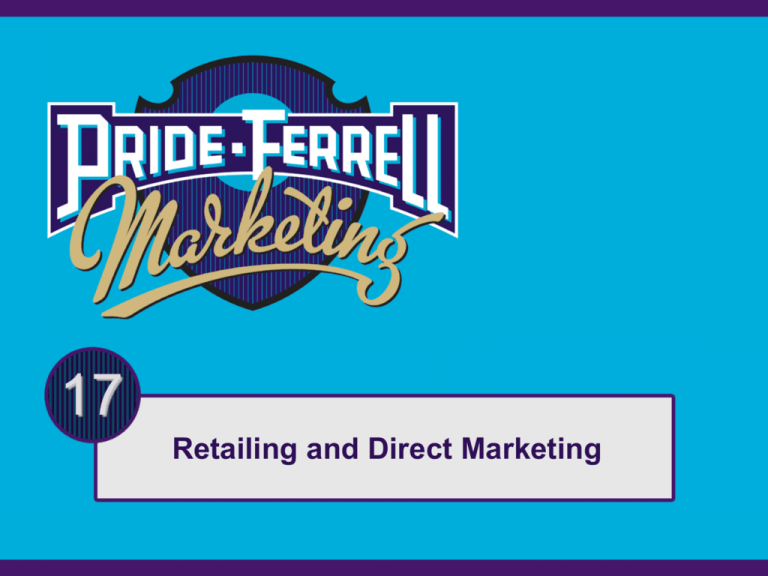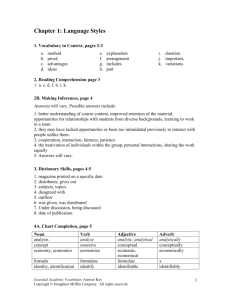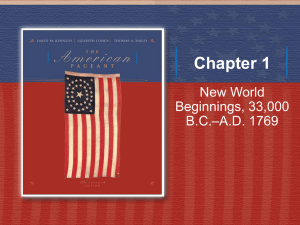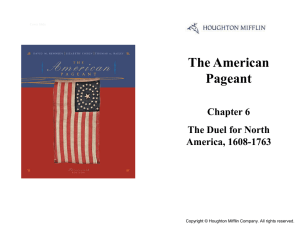
17
Retailing and Direct Marketing
Agenda
•
•
•
•
•
•
The Nature of Retailing
Major Types of Retail Stores
Direct Marketing
Other Types of Nonstore Retailing
Franchising
Strategic Issues in Retailing
Copyright © Houghton Mifflin Company. All rights reserved.
17 | 2
The Nature of Retailing
• Retailing
– Transactions in which ultimate consumers are the
buyers
• Retailers
– Organizations that purchase products for the
purpose of reselling them to ultimate consumers
• Retailers add value — shopping convenience,
services, and purchasing assistance to customers
• Retailers create utility — time, place, possession, and
form
– Success in retailing comes from having a strong
customer focus coupled with desired levels of
service, product quality, and innovation.
Copyright © Houghton Mifflin Company. All rights reserved.
17 | 3
Major Types of Retail Stores
• General-Merchandise Retailers
– A retail establishment that offers a variety
of product lines
– Department stores
• Large retail organizations characterized by
wide product mixes and organized into
separate departments to facilitate marketing
efforts and internal management
– Discount stores
• Self-service, general merchandise stores
offering brand name and private brand
products at low prices
Copyright © Houghton Mifflin Company. All rights reserved.
17 | 4
Major Types of Retail Stores (cont’d)
• General-Merchandise Retailers (cont’d)
– Supermarkets
• Large, self-service stores
that carry a complete line
of food products, along
with some nonfood
products
– Superstores
• Giant retail outlets that carry food and nonfood
products found in supermarkets, as well as
most routinely purchased consumer products
Copyright © Houghton Mifflin Company. All rights reserved.
17 | 5
Major Types of Retail Stores (cont’d)
• General-Merchandise Retailers (cont’d)
– Warehouse clubs
• Large-scale, members-only establishments
that combine features of cash-and-carry
wholesaling with discount retailing
Copyright © Houghton Mifflin Company. All rights reserved.
17 | 6
Major Types of Retail Stores (cont’d)
• Specialty Retailers
– Traditional specialty retailers
• Also called “limited-line” and “single-line”
retailers
• Carry a narrow product mix with deep product
lines (e.g., pet supplies)
• Have higher costs and higher margins
• Provide more product selection (first-line
brands), product expertise, and high levels of
personal service
Copyright © Houghton Mifflin Company. All rights reserved.
17 | 7
Traditional Specialty Retailer
© Carol Lundeen
Copyright © Houghton Mifflin Company. All rights reserved.
17 | 8
Major Types of Retail Stores (cont’d)
• Specialty Retailers (cont’d)
– Off-price retailers
• Buy manufacturers’ seconds, overruns, returns, and offseason merchandise for resale to consumers at deep
discounts
• Charge less than department stores for comparable
merchandise and offer few customer services
• Have established long-term relationships with suppliers
for continuing supplies of reduced-price goods
– Category killers (“big box”)
• Concentrate on a major product category and compete
on the basis of low prices and product availability
Copyright © Houghton Mifflin Company. All rights reserved.
17 | 9
Examples of Category Killers
•
•
•
•
•
•
Toys ‘R’ Us
Home Depot
Best Buy
Office Depot
PETsMart
Barnes & Noble
Copyright © Houghton Mifflin Company. All rights reserved.
17 | 10
Direct Marketing
• Nonstore Retailing
– The selling of products outside the
confines of a retail facility
• Direct Marketing
– The use of telephone
and nonpersonal
media to introduce
products to consumers,
who then can purchase
them via mail, telephone,
or the Internet
Copyright © Houghton Mifflin Company. All rights reserved.
17 | 11
Direct Marketing (cont’d)
• Catalog Marketing
– A type of marketing in which an
organization provides a catalog from which
customers can make selections and place
orders by mail, telephone, or the Internet
• Consumer advantages are efficiency and
convenience
• Marketer advantages are lower location,
facility, selling, and operating costs.
• Disadvantages are inflexibility and limited
selection and local service availability.
Copyright © Houghton Mifflin Company. All rights reserved.
17 | 12
Direct Marketing (cont’d)
• Direct-Response Marketing
– A type of marketing that occurs when a
retailer advertises a product and makes it
available through mail or telephone orders
• Telemarketing
– The performance of
marketing-related
activities by telephone
Copyright © Houghton Mifflin Company. All rights reserved.
17 | 13
Customers’ Reactions to Telemarketing Calls
How can telemarketers be more effective in reaching customers?
Source: “Do Not Disturb,” American Demographics, May 2001, p. 28. Adapted with permission.
Copyright © Houghton Mifflin Company. All rights reserved.
17 | 14
Direct Marketing (cont’d)
• Television Home Shopping
– A form of selling in which products are
presented to television viewers, who can
buy them by calling a
toll-free number and paying
with a credit card
• Online Retailing
– Retailing that makes
products available to
buyers through computer
connections
Copyright © Houghton Mifflin Company. All rights reserved.
17 | 15
Satisfaction Scores for Online Retailers
American Customer Satisfaction Index Year-to-Year Comparison
E-Retail Online Brand
2002
2003
% Change
Amazon.com
88
88
0%
Barnesandnoble.com
87
86
-1.1%
Buy.com
80
80
0%
1-800-Flowers.com
78
76
-2.6%
All others
82
83
1.2%
Average e-tailer
83
84
1.2%
Source: ACSI as reported in American Demographics, April 2004, p.16.
Copyright © Houghton Mifflin Company. All rights reserved.
17 | 16
Satisfaction Scores for Online Retailers
(cont’d)
American Customer Satisfaction Index Year-to-Year Comparison
E-Travel Online Brand
2002
2003
% Change
Expedia
80
78
-2.5%
Orbitz
76
77
1.3%
Travelocity.com
76
76
0%
All others
77
77
0%
Average e-travel score
77
77
0%
Source: ACSI as reported in American Demographics, April 2004, p.16.
Copyright © Houghton Mifflin Company. All rights reserved.
17 | 17
Other Types of Nonstore Retailing
• Direct Selling
– The marketing of products to ultimate consumers
through face-to-face sales presentations at home
or in the workplace
• “Door-to-door”
• Party plans: hosting groups to view a product
demonstration and encouraging participants to
purchase the products
– Benefits
• Personal attention to customer
• Convenience of time and place of presentation
– Limitations
• High costs make it the most expensive form of selling
• Negative consumer view of direct selling
Copyright © Houghton Mifflin Company. All rights reserved.
17 | 18
Other Types of Nonstore Retailing (cont’d)
• Automatic Vending
– The use of machines to dispense products
– Can include items such as candy, chewing
gum, soft drinks, cigarettes, newspapers,
and coffee
• Advantages: small amount of
space needed and no sales
personnel
• Disadvantages: high costs of
equipment and frequent servicing
Copyright © Houghton Mifflin Company. All rights reserved.
17 | 19
Franchising
• Franchising
– An arrangement in which a supplier
(franchiser) grants a dealer (franchisee)
the right to sell products in exchange for
some type of consideration
• Franchiser furnishes equipment,
buildings, management know-how,
and marketing assistance.
• Franchisee supplies labor and
capital and operates the business
by the provisions of the franchise
agreement.
Copyright © Houghton Mifflin Company. All rights reserved.
17 | 20
Copyright © Houghton Mifflin Company. All rights reserved.
17 | 21
Franchising (cont’d)
• Advantages
–Enables startup with
limited capital
–Provides developed
and proven business to
franchisee
–Attracts customers
with established brand
name
–Allows immediate
market entry
–Motivates franchisee
to succeed
Copyright © Houghton Mifflin Company. All rights reserved.
• Disadvantages
–Control over aspects
of the business and its
operations by
franchiser
–Expense of
continuing franchise
royalties and
advertising fees
–Lack of control of
franchisees by
franchisor
17 | 22
If You Had the Financial Resources to Purchase a
Franchise, Which Company Would You Select? Why?
Reprinted with permission of Papa John’s International, Inc.
Copyright © Houghton Mifflin Company. All rights reserved.
17 | 23
Strategic Issues in Retailing
• Retail Store Location
– Factors affecting location
• Intended target market
• Kinds of products
• Suitability site for customer
access
• Characteristics of existing
retail operations
• Types of Locations
– Free-standing structures
– Traditional business districts
Copyright © Houghton Mifflin Company. All rights reserved.
17 | 24
Strategic Issues in Retailing (cont’d)
• Traditional Shopping Centers
– Neighborhood shopping centers
• Usually consist of several small convenience
and specialty stores.
– Community shopping centers
• Include one or more department stores
(anchors), some specialty stores, and
convenience stores.
– Regional shopping centers
• Have the largest department stores, the widest
product mix, and the deepest product lines of
all shopping centers.
Copyright © Houghton Mifflin Company. All rights reserved.
17 | 25
Strategic Issues in Retailing (cont’d)
• Nontraditional Shopping Centers
– Factory outlet malls
• Feature discount and factory outlet stores
carrying traditional brand name products
– Miniwarehouse mall
• Loosely planned; lease space to retailers
running retail stores out of warehouse bays
– Nonanchored malls
• Do not have traditional department store
anchors; combine off-price and category killer
stores in a “power center” format
Copyright © Houghton Mifflin Company. All rights reserved.
17 | 26
Strategic Issues in Retailing (cont’d)
• Retail Positioning
– Identifying an unserved or underserved market
segment and serving it through a strategy that
distinguishes the retailer from others in the minds
of consumers in that segment
• Store Image
– Atmospherics
• The physical elements in a store’s design that appeal to
consumers’ emotions and encourage buying
• Interior layout, colors, furnishings, and lighting
• Exterior storefront and entrance design, display
windows, and traffic congestion
Copyright © Houghton Mifflin Company. All rights reserved.
17 | 27
How to Succeed in Retailing as a Small Business
1.
2.
3.
4.
5.
6.
7.
Differentiate your product from that of the other stores
(avoid direct competition).
Determine your specific niche…you can’t please
everyone.
Select a location with easy access and high visibility.
Offer products with selling features.
Train your employees to develop strong
employee/customer relationships.
Plan store-related events to create excitement.
Focus your ad dollars on one medium versus
inadequately buying many media.
Source: Reprinted with permission from Arthur Andersen Retailing Issues Letter, July 1995, Vol. 7, No. 4, p. 5. Used with permission.
Copyright © Houghton Mifflin Company. All rights reserved.
17 | 28



